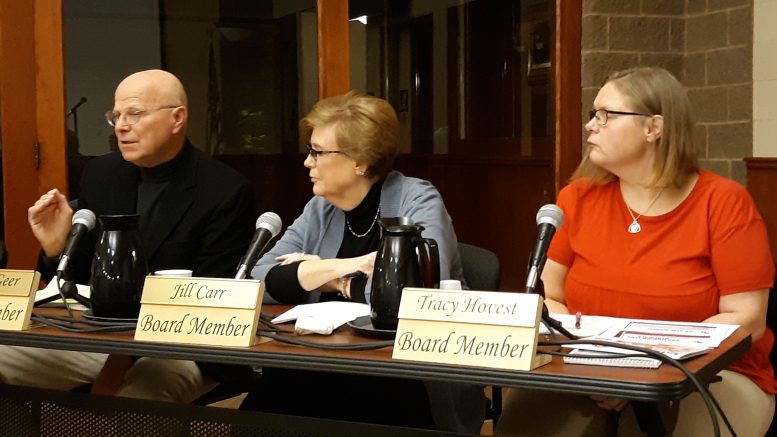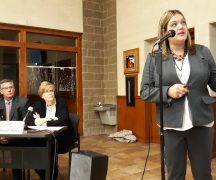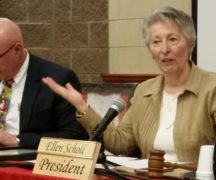By JAN LARSON McLAUGHLIN
BG Independent News
Across Ohio, public schools have lost an estimated $107 million in state funding, and have seen an exodus of 22,638 students to private schools through the EdChoice voucher program.
Bowling Green City Schools is one of more than 1,200 schools being hit by the EdChoice penalties. Officials estimate the district may lose close to $500,000 in state funding over the next four years.
So on Tuesday, the Bowling Green Board of Education passed a resolution protesting the state program, which requires districts designated as EdChoice to pay vouchers for students wanting to attend private schools.
“When the money leaves the district, it never comes back,” said School Board President Ginny Stewart. “It’s an assault on public schools.”
Last week Bowling Green school officials – Superintendent Francis Scruci, board members Ginny Stewart, Jill Carr and Norm Geer, and Angie Schaal, the district’s executive director of teaching and learning – met with other school districts to express their concerns about EdChoice to State Sen. Theresa Gavarone, R-Bowling Green.
“There’s a real problem with supporting public education in Ohio,” Geer said.
Draining funds from public schools means the districts have to go back to taxpayers more often since money is being diverted to private schools, he said.
“It’s a tremendous draw on public funds,” Geer said.
And there’s a real problem with good schools being labeled as “failing,” he said, noting that schools like Anthony Wayne are on the EdChoice list.
“These are not under-performing schools,” Geer said. “The point is Bowling Green has good schools, Anthony Wayne has good schools.”
Gavarone told school officials last week that the state is working on changes to the EdChoice program. But time is ticking away toward the Feb. 1 deadline when applications to private schools become available for students in this year’s round of EdChoice schools.
“There’s an urgency involved,” Geer said. “Something has to be done by Feb. 1.”
But school board member Bill Clifford expressed his skepticism that a solution will be provided by then. He pointed out the decades-long failure of the state legislature to correct the school funding issue that was deemed unconstitutional by the Ohio Supreme Court.
“There’s a big push throughout the state to get our legislators to listen,” Scruci said Tuesday evening.
The opposition to EdChoice has united school districts across the state, he said.
“We are all losing a lot of money out of our district,” Scruci said.
One solution proposed by school officials has been to ensure that no district can be demoted to EdChoice if it has an overall state report card grade of A, B or C.
“That seems to be getting some traction,” Scruci said.

At the board meeting, citizen Ken Rieman questioned the rationale of the EdChoice program, which can result in a loss of $4,650 for each elementary student that leaves for a private school. That compares to $2,213 that the state pays Bowling Green per elementary student.
“That’s a significantly higher amount,” Rieman said. “There’s no equity.”
“People need to understand there’s no equity in EdChoice,” he said. “This program is not fair.”
School buildings can be demoted to EdChoice status for a host of reasons. The designation means that any student at an EdChoice school can get state scholarship money to go to a private school – until they graduate high school.
In Bowling Green, Crim Elementary recently joined Kenwood Elementary in the distinction. Others in Wood County are Lake high school and middle school, and Northwood elementary and high school.
The number of EdChoice schools in Ohio nearly doubled last year – to more than 1,200. The Ohio School Board Association has predicted that 2,000 schools will drop into the category by next year.
The private schools taking in the students get “scholarships” of $4,650 a year for K-8 grades, and $6,000 a year for 9-12 grades.
Meanwhile, for each child leaving Kenwood Elementary, the school district loses $2,213 a year from the state, plus has to pay up to an additional $2,437 to the private school. That adds up to a potential total loss to the district of $4,650 per student.
Even if Crim and Kenwood shed the EdChoice designation in a few years, the expenses could linger. The state program allows parents of kindergartners to take them out of the public school and place them in private facilities all the way through graduation.
The bigger goal sought by school officials on Friday was to look beyond a moratorium to examine the overall EdChoice program that is causing students to flee to private and parochial schools, and siphoning money from public schools to pay for their scholarships.
Some very wealthy districts, with very high test scores, have been demoted through EdChoice. Lake Schools has gone from a district rated as “excellent with distinction” to failing under EdChoice. And Bowling Green received three consecutive years of “Momentum Awards” from the state – then got hit with the EdChoice demotion. In Bowling Green, the ranking was based on K-3 literacy test results from 2013-14, 2017-18 and 2018-19.
The practice is found troubling to many facing the demotion.
First, the scholarships aren’t given to the students who struggled with the state testing. Instead, the top students may choose to leave for private schools – making it even harder for the EdChoice school to reach the grades it needs to shed the designation.
Second, the publicly funded scholarships are paid to private and parochial schools – which don’t undergo the rigorous state testing required of public schools. So transferring to private schools may or may not benefit the students.
And third, for every student who leaves an EdChoice school, the district loses state funding. So some are posing the question of who suffers in the long run when a district has less to spend on education.

Toward the end of the board meeting on Tuesday, citizen Grant Chamberlain asked to see the public notice of the three board members attending the meeting with other districts and Gavarone.
Stewart said the three board members did not drive together, did not sit together at the meeting, and did not discuss Bowling Green schools at the meeting.
Chamberlain also asked for an update on the district’s efforts to join the Ohio Checkbook System. Treasurer Cathy Schuller said she has met with people at the state treasurer’s office, which is building a platform for Bowling Green to participate in the program.





